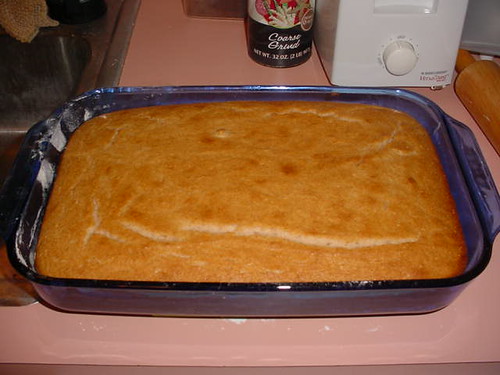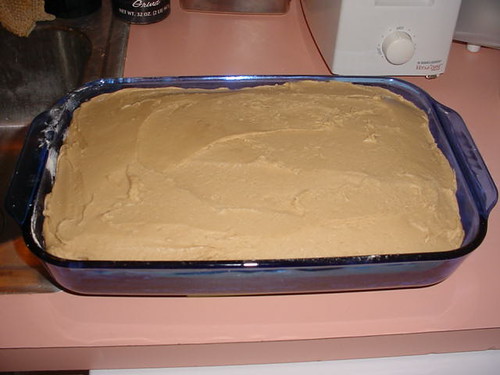It's called "Dinette spice cake." The recipe came from the Betty Crocker Cooking For Two cookbook I have. I have no idea if this book is still in print or not - mine is actually a vintage 1958 copy, the little spiral bound version. I got it from my mom, who somehow wound up with two copies. (I think she said at least one was a wedding gift; I think the big-format one, which she still has, was the wedding gift).
If the book is no longer in print, it should be brought back. It's an excellent "basic" cookbook for people wanting to make small quantities. (And extra fun: it is the one with the somewhat-famous illustrations by Charles Harper, a well-known midcentury artist, who is enjoying sort of a posthumous renaissance right now).
The food in it is fairly plain, but as I've said before: I like plain food. It's the book where I got my recipe for Senate bean soup, it's the book that supplied the brownie recipe that my mother *always* used when my brother and I were growing up. It has good sections on how to do the basic preparations of meat and vegetables, and "how much should I buy for two," and what a small kitchen really needs in the way of tools.
It also has an interesting "recipes from foreign lands" section at the end (some being more authentic than others; the German menu seems to be one of the least spurious-sounding to me. And they classify Hawaii as a "foreign land," well, I guess it kind of was, seeing as the book came out before it was actually a state.)
Anyway, I doubled the "Dinette Cake" recipe, and used the "spice cake" variation of it.

However, one change: the original recipe (for an 8 by 8 pan) called for 1/2 teaspoon of cloves - which would be a whole teaspoon in my doubling. That's way too much cloves! If you had a toothache, it might be good, but otherwise, it would put your mouth to sleep.
So instead, I put in the requested amount of cinnamon (for the doubled recipe) and then just added 1 teaspoon of the Penzey's "Cake Spice" (which has some cloves in it, also cinnamon, nutmeg, and star anise).
It smelled fantastic while baking and came out looking very nice (see above), so I hope it tastes as good as it looks.
(One other change: the order of adding ingredients seemed strange. It told you to mix all the dry ingredients - sugar and flour and leavening and spices - and then mix in the shortening, then add the eggs, and finally add the milk. That seemed to me like it might promise a tough cake (too much mixing once the flour is in is bad), so I defaulted to my standard cake procedure: cream shortening and sugar first, then add eggs and vanilla, then combine the dry ingredients and add alternately with milk. The batter came out very light textured and the cake rose well, so I think I may have made a good decision there.)
I also did the recommended frosting - called "easy penuche frosting." It's reminiscent of a cooked caramel frosting my mother used to make. That took some doing; you have to boil together the butter, brown sugar, and milk, and then wait for-ev-er while it cools (and DO NOT stick a knuckle into the still-hot mixture to test. Sugar syrup burns.)
But I finally got it cooled, beaten with the powdered sugar, and got the cake frosted.

I tried a bit of the leftover frosting and it is extremely sweet. I hope putting a thin layer on top of a fairly plain cake will tone down the sweetness.
(I once said I wasn't crazy about frosting cakes. Part of that is that I'm just not that fond of making frosting, but the other part is most non-fiddly (i.e., not 7-minute boiled) frostings are excessively sweet to my taste. I said that this frosting was reminiscent of a caramel frosting my mother used to make but I do not remember it as being so sweet. Then again, maybe when I was a child, extremely sweet things appealed to me more than they do now).
(Incidentally, I love the seven-minute boiled frosting - I think some people call it "seafoam" but I know that as a boiled frosting made with brown sugar - it is about my favorite frosting but it's such a pain to make, especially with just one person to work on it, so I never do it. My mother used to make a wonderful cake where she'd make a plain white cake, then frost it with the seven minute frosting into which she had added ground-up raisins).
I enjoy baking from scratch but rarely have the time to do it, unless I have somewhere to take the finished product. I think it would be interesting to go back through the various "vintage" cookbooks (I own quite a few and I think my university library has a few) and extract some of the unusual old recipes and bake them up just to see what they're like. And blog on them. (Though the blogosphere being what it is, I'm sure there's already someone out there already cooking their way through vintage cookbooks, probably even more impressively-vintage cookbooks than the ones I own).
And also, there'd be the problem of finding enough people willing to eat up the results, especially for the larger cakes or batches of cookies.
One thing I want to make some time is a recipe called "Bishop's Bread" that is in several of my older cookbooks (I think the Settlement House cookbook has one variation. It's kind of a shortbread sort of thing, with nuts and fruit in it.







